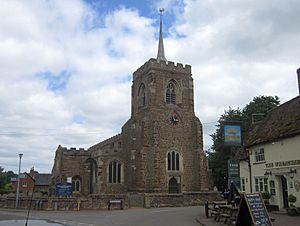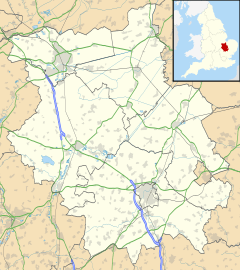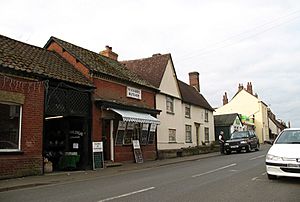Gamlingay facts for kids
Quick facts for kids Gamlingay |
|
|---|---|
 Village centre: St Mary's Church and the pub |
|
| Population | 3,247 |
| OS grid reference | TL236526 |
| District |
|
| Shire county | |
| Region | |
| Country | England |
| Sovereign state | United Kingdom |
| Post town | SANDY |
| Postcode district | SG19 |
| Dialling code | 01767 |
| Police | Cambridgeshire |
| Fire | Cambridgeshire |
| Ambulance | East of England |
| EU Parliament | East of England |
| UK Parliament |
|
Gamlingay is a village and civil parish in Cambridgeshire, England. It is located about 22 kilometers (14 miles) west-southwest of Cambridge.
In 2011, the village had a population of 3,247 people. The entire civil parish, which includes areas like Gamlingay Cinques and Gamlingay Great Heath, had 3,568 residents.
Contents
History of Gamlingay
Gamlingay is a very old village. It was even mentioned in the Domesday Book of 1086. The name Gamelingei comes from Old English. It means "the enclosed land of Gamela's people."
People have lived here since the middle Bronze Age. There are also signs of even older settlements from the middle Stone Age. The village likely started around a central green. This area is now called Church Street. Some old medieval buildings were once there. Today, only a tithe barn and a house called 'Emplins' remain.
Another important spot was the crossroads on Church Street. Houses grew around this area. By 1801, Gamlingay was a large village. It had twice the population of the next biggest parish nearby.
Village Life and Changes
Gamlingay has a rich history. Many buildings in the village are very old and important. The stone for building the local church came from a quarry in the village. This quarry later became a safe place for archery practice. It was called 'The Butts'. In medieval times, men had to learn how to use a bow and arrow. Today, 'The Butts' is a children's play area.
For many centuries, Gamlingay was a farming village. Most of the land was owned by colleges from Oxford and Cambridge. These included Merton College, Downing College, and Clare College. The local school, Gamlingay Village College, even named its houses after these colleges for a while.
In 1600, a "Great Fire of Gamlingay" destroyed many homes. About 64 houses, which was a large part of the village, were burned down. This was a big disaster for the community.
Gamlingay was once a busy stop for coaches. In 1844, it had five inns. Some of these, like the Cock and the Rose & Crown, were very old. It is even said that the famous highwayman Dick Turpin rode through Gamlingay.
The village also had a train station. It opened in 1862 and was part of the line between Bedford and Cambridge. However, it closed in 1968.
How Gamlingay is Governed
Gamlingay has a local council called the Gamlingay Parish Council. It has 15 members who help run the village.
The village is also part of larger government areas. It has one councillor on the South Cambridgeshire District Council. It also has one councillor on the Cambridgeshire County Council. For national elections, Gamlingay is part of the South Cambridgeshire area. This area is represented in the UK Parliament by a Member of Parliament.
Geography of Gamlingay
Gamlingay is located about 22 kilometers (14 miles) west of Cambridge. It is also about 9 kilometers (5 miles) southeast of St Neots. London is about 72 kilometers (45 miles) to the north.
The village sits at about 50 meters above sea level. The land in the parish ranges from 39 meters to 73 meters high. The soil in the central part of the parish is sandy. The eastern part has clay soil.
Gamlingay has two important nature areas. Gamlingay Wood is a Site of Special Scientific Interest. This means it is protected for its wildlife. Gamlingay Cinques Common is a County Wildlife Site. These places are important for local plants and animals.
In the past, there were heathlands and even two quaking bogs in the area. These bogs were drained in the 1800s.
Economy and Jobs
Today, many people who live in Gamlingay travel to work. It is mostly a commuter village. About 44% of working residents travel outside of Cambridgeshire for their jobs.
For many centuries, farming was the main job in Gamlingay. Farmers grew crops like wheat, barley, and peas. In the past, there were also gravel pits and brickworks in the village. One brickworks was very large, covering 12.5 hectares (31 acres). It could hold 500,000 bricks! When the brickworks closed, the village's population went down.
Important Landmarks
Gamlingay has a war memorial made of Cornish granite. It honors the men from the village who died in the First World War and Second World War. It is now located in the new cemetery.
There are also two very old timber-framed buildings. These are Emplins and Merton Manor Farm. They date back to the late 1400s or early 1500s. In total, 60 buildings in Gamlingay are listed. This means they are important for their history or architecture. These include the Baptist chapel, the Cock Inn, and a red telephone box outside the church.
Transport in Gamlingay
The B1040 road goes through Gamlingay. It connects to nearby towns like Potton and the A14. Smaller roads lead to other villages.
The closest train station is in Sandy, Bedfordshire. Buses also run from Gamlingay to places like Cambridge, St Neots, and Sandy.
Education for Young People
Since 2017, Gamlingay schools follow the national two-tier system. Children aged 4 to 11 go to Gamlingay Village Primary. This school is part of the Cam Academy Trust.
After primary school, students aged 11 to 16 attend Comberton Village College. This school is also part of the Cam Academy Trust and is highly rated. A free school bus is provided for students. Other nearby secondary schools include Sandy Secondary School and Stratton Upper School.
Religious Sites
The main church in Gamlingay is St Mary's Church. It was built around the 12th century. The church has a square tower with eight bells. It is made from local stones.
Gamlingay also has a Baptist church. The first Baptist church here was formed in 1670. Its first minister was John Bunyan, who wrote the famous book The Pilgrim's Progress. The church building was rebuilt in 1840. Today, the Gamlingay Baptist Church still meets every Sunday.
Other chapels existed in the past. There was a chapel called Zoar at Gamlingay Cinques, built around 1800. There was also a Primitive Methodist chapel built in 1855.
Community Life
Gamlingay has many things for the community. These include a gym, two pubs, and several shops. There are also hairdressers, sports fields, and a community center. People can join different clubs and societies. The village even has its own cinema.
Gamlingay is also home to the Gamlingay Eco Hub. It also has a community music charity called Gamlingay Records.
Famous People from Gamlingay
- Sir George Downing, 1st Baronet (1623–1684) – A politician who helped build Downing Street in London.
- Sir George Downing, 3rd Baronet (1685–1749) – A politician who founded Downing College at Cambridge University.
- Jeremy Irvine – An actor who grew up in Gamlingay.
- Dick Turpin – A famous highwayman who is said to have ridden through Gamlingay.
Images for kids
See also
 In Spanish: Gamlingay para niños
In Spanish: Gamlingay para niños







